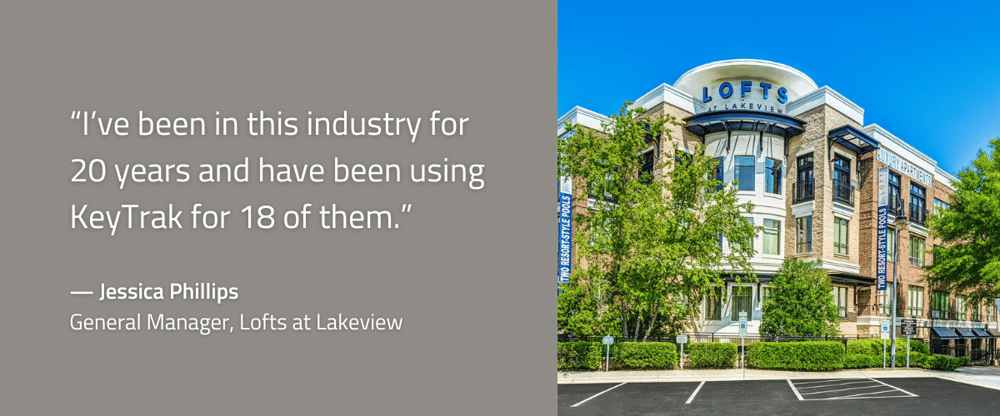Whether you're overseeing a dealership, multifamily property, commercial business, or university, a strong key management system is essential for effective physical security. But how do you select the best system? We'll explore two important aspects: the system features and the company behind it.
System Capabilities
A key management system should be a good fit for your business now while being flexible enough to grow with you. Here are the main factors to consider:
Customization Level
Assess whether the system offers customization to meet your specific requirements or if it provides standard, prefigured solutions. While standard options are more cost-effective, they’re less flexible.
Key Capacity
Look for a system with options designed to accommodate your key control needs. It should have enough capacity for your current key volume as well as offer easy expansion by adding additional drawers or panels.

KeyTrak Edge and KeyTrak Guardian systems are easily expandable by adding additional drawers or panels.
On the other hand, if you have a small number of keys and don’t plan to add more, look for a system that’s appropriately sized for your key inventory so you’re not paying for space and features you won’t use.

KeyTrak EdgeSL systems are ideal for organizations with smaller key capacity.
Asset Management
Some key control systems provide the option to manage more than basic metal keys through specialized drawers, panels, and lockers. Consider what types of assets require an audit trail and ask potential key control providers what asset management capabilities their systems offer.
These items could include:
- Auto dealership license plates
- Small devices
- Access cards or credit cards
- Law enforcement evidence

KeyTrak Edge systems have the option for a license plate drawer.

KeyTrak Guardian systems feature the option for electronic lockers and card modules.
Software Designed for Your Industry
One-size-fits-all software isn’t ideal because every industry has different needs:
- Automotive dealerships need to manage high vehicle turnover and track test drives.
- Apartment communities need to manage access to resident apartments.
- Universities need to secure multiple kinds of keys to campus buildings, residence halls, fleet vehicles, and more.
These are just a few examples. When choosing a key control system, make sure the software will work for your organization’s needs.
Security Features
A key control system’s security features are what set it apart from a basic pegboard on the wall. However, different systems have different levels of security. The following features provide additional security and user accountability:
- Automatic Audit Trail: The system records the transaction as soon as a user removes a key, with no manual steps required.
- Multiple User Login Methods: Multifactor authentication is a security best practice that involves combining two or more login methods (fingerprint, fob, badge, password) that reduces the risk of credential sharing.
- Motion-Activated Security Camera: Surveillance footage shows who has approached the system, even if they didn’t attempt to log on.
- Audible Alarms and Email Notifications for Potential Breaches: Automatic alerts allow you to respond to potential incidents quickly.
- Total Lockdown Drawers or Panels: Keys are physically locked in place, preventing a user from removing keys outside their access level.
Ease of Use
If accessing the system entails a cumbersome, complicated process, employees are more likely to get frustrated and circumvent protocol. Look for features that enhance ease of use without compromising security, including:
- Minimal manual steps (such as scanning key tags)
- Light-up key tags that allow a user to find the requested key quickly
- Remote access to allow managers to check key activity from their desks
- Mobile app to manage keys on the go
Reporting
Reports detailing information such as key inventory, keys currently checked out, and the names of the employees using keys provide management personnel with an easily viewable summary of company activity. When evaluating a system’s reporting capabilities, ask the following questions:
- What standard reports are included?
- Does it have the option to create custom reports?
- Can the system automatically email reports to specific people?
- If you’ll have multiple networked systems, can reports be aggregated?
- Can you access reports remotely?
User Management
To maintain strict control over key access and enhance employee accountability, ensure your key management system includes these capabilities:
- Role-based user access levels
- Time-based access restrictions
- Deactivation date for employees who only need key access for a limited time
- Reports showing specific users’ key activity
- Requirement for dual authentication (two separate users must enter their credentials to remove high-security keys)
Integrations
Consider what integration options are available to keep your data current across your key control system and third-party databases. These options might include direct integrations with specific software platforms or the flexibility to connect with a third-party system of your choice.
Disaster Recovery
Ensuring your key management system remains functional during emergencies is crucial for maintaining security and access. When evaluating a key control system, assess its disaster recovery capabilities:
- Power Backup: How is the system powered in the event of a power outage? Having an uninterruptible power supply (UPS) keeps the system running and minimizes downtime.
- Access Procedures: Know how users can gain access to keys in the event of a power outage.
- Data Backup: System data should be regularly and automatically backed up to the cloud or an off-site location.
Additional Features
A well-rounded key management system can provide more than just key control. Consider these added features that can help optimize various aspects of your business:
- Location Tracking: Features that allow you to track the real-time location of keys or vehicles help provide an additional layer of security and accountability.
- Package Tracking: This function allows you to log and monitor the movement of packages, ensuring they’re delivered to the correct recipients.
- Prospect Tracking: With driver’s license scanners, you can quickly scan and store visitor or prospect information, making it easier to manage and reference when needed.
- Work Order Management: This function allows maintenance personnel to create, assign, and track work orders.
- Parts Tracking: With parts tracking, you can maintain an accurate inventory of parts, preventing shortages and ensuring that necessary supplies are always on hand.
- Time Clock: The time clock function integrates employee timekeeping into your key management system.
Selecting the right key management system ensures both immediate security and long-term adaptability. By considering system features, integration options, and disaster recovery capabilities, you can invest in a solution that supports your business’s evolving needs and provides lasting value.
The Right Key Control Technology Partner
Selecting a key management system is a significant investment, and choosing the right technology partner is crucial. As you consider your options, evaluate technology providers on the following criteria:
Longevity
Assessing how long a technology provider has been in business can provide valuable insight into its reliability and experience. A well-established company with a substantial installation history is likely to have a proven track record of delivering effective solutions and supporting customers over time.

Local Representation
While entirely online transactions are common for many technology solutions, an on-site demo from a local representative gives you firsthand experience with the system and insight into the company's values. It also allows the rep to evaluate your facility and determine what key control system would best suit your needs.
Installation
Before purchasing a key control system, find out if the vendor will provide installation services or if you’ll be required to install the system. This knowledge is especially important if the installation process is complex and requires specific expertise to ensure the system functions correctly from the start.
Support
Reliable support is essential for keeping your key management system functioning smoothly and addressing any issues that may arise. When evaluating support options, consider the following aspects to ensure you receive timely and effective assistance:
- Hours: Ask about available support hours and ensure they work for your organization.
- In-House vs. Outsourced: Choose a vendor that offers in-house support to ensure knowledgeable employees who are familiar with the system handle any issues, rather than relying on third parties who may lack the same level of expertise and commitment.
- Included Warranty: Check if the vendor includes standard support coverage with your system purchase. Find out how long the warranty lasts and what it includes (phone support, software updates, assistance with hardware issues, parts replacement, etc.).
- Extended Support: Consider whether the vendor offers maintenance agreements for extended coverage, providing benefits like predictable support costs, additional on-site services, and discounts on supplies.

Training
Inquire about the training options the vendor offers. Effective training empowers your team to fully utilize the system's features, minimizing the risk of user errors and maximizing the return on your investment. Ask whether the training is provided in-person, online, or through a combination of both.
Investing in a key management system is about more than just securing keys. It's about finding a solution that integrates seamlessly with your operations, grows with your business, and comes with the support you need to get the most out of your investment.
The right key management system, backed by the right partner, can save you thousands in potential losses and rekeying costs. Take the time to evaluate your options carefully, and you'll end up with a solution that keeps your business secure and running smoothly for years to come.
Originally published in 2013 and updated in 2024.


